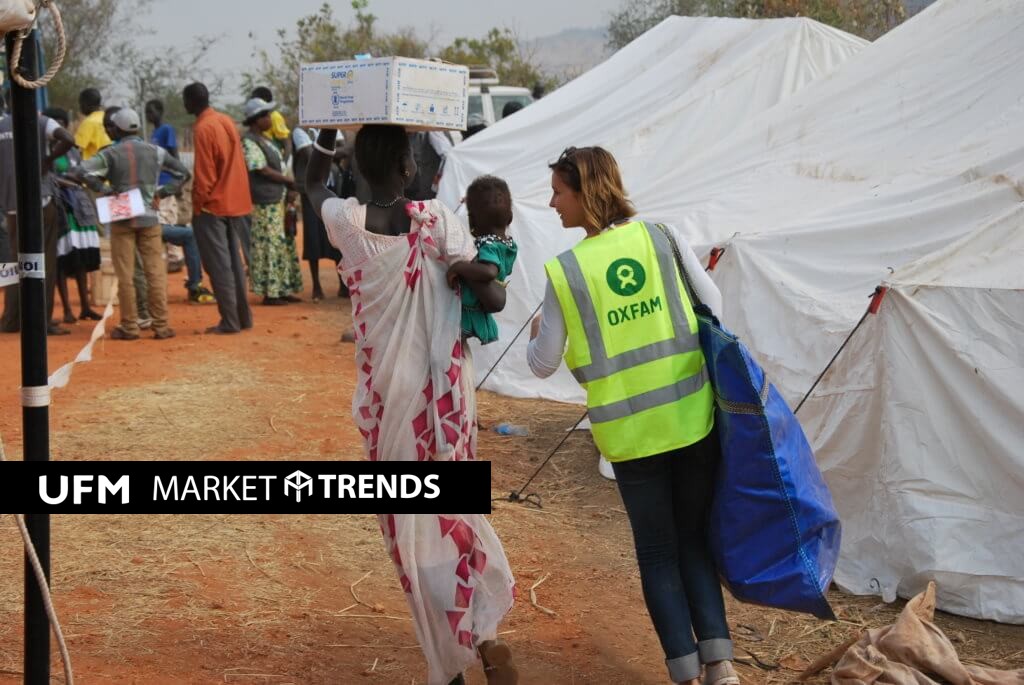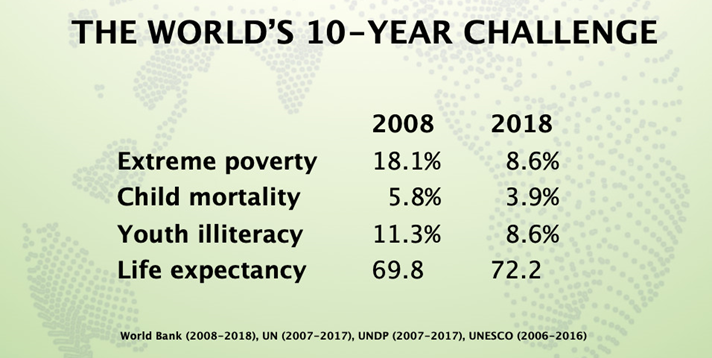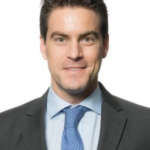The Half-Truths of the OXFAM Report

On January 21, the NGO OXFAM published a controversial report that got a lot of play in the media. Following its tradition, the organization published its report days before the Davos Conference began.
Of course, OXFAM knows how to draw attention to its messages. In its latest report, the NGO assures readers that the twenty-six richest people in the world have the same wealth as the poorest half of the population.
Reading the report makes you think that you are living on an apocalyptic planet of Hobbesian servitude, where the only principle that governs our society is “Homo homini lupus” (Man is a wolf to man).
OXFAM’s annual report has twisted its approach. Currently, the focus is not so much on poverty, but rather on inequality. I believe this is so for the two following reasons:
- In recent years, wealth worldwide has seen unprecedented growth, for the rich as well as for the poor. The main indicators that measure poverty have not stopped improving. While in 1990 the World Bank considered that 36 percent of the world’s population lived in extreme poverty, last year this percentage was reduced to only 8 percent. That means that approximately 1.1 billion people have been able to escape extreme poverty—the equivalent of twenty-three times the population of Spain.
- Last year was the annus horribilis for OXFAM. Its reputation as an organization that strives to work to eradicate poverty was questioned. In February of last year, Juan Alberto Fuentes, then president of OXFAM, was arrested in Guatemala for fraud amounting to millions of dollars.
This arrest occurred only a few days after the biggest scandal in the history of OXFAM broke. After an earthquake in 2010 destroyed Haiti—by far the poorest country in the Americas—the head of the organization in Haiti, along with other collaborators, admitted to hiring prostitutes and taking them to the OXFAM offices in Haiti.
With all of these scandals, it is surprising that the NGO continues to give lessons on how to achieve a better world. But let’s consider what went into OXFAM’s report.
There are many who are bringing to light the dubious methodology that was used to draw the conclusion that the twenty-six richest people in the world have the same wealth as the poorest half of the population.
OXFAM calculates people’s wealth as if they were balance sheets, without taking into account income. That is, only an individual with positive net assets (assets minus debts) is considered as rich. It also fails to take into account income or the adjustment effect of purchasing power, and so on. The methodology seems very unrigorous. Consider the case of a successful entrepreneur with a large income who has requested a loan to start a business. According to OXFAM, if the debt she repays is greater than the assets she owns, then this person is in a worse situation than another who has no assets or liabilities. There are many people in the world who not only risk their own capital, but ask for loans for business projects and can still afford a wealthy lifestyle despite being temporarily in debt. This concept is not included in the OXFAM methodology. It is also eye-catching that Gini Coefficient, the most frequent ratio to represent wealth distribution, is not mention at all.
There are many surprising things in this study. Here are some that especially struck me:
- According to the report, the richest people on the planet are hiding $7.6 trillion. Yet the report contains an even more surprising figure: the economic value of the unpaid tasks performed by women in some parts of the world exceeds $10 trillion. Amazing! They have uncovered 20 percent of the world’s GDP, which in 2017 was approximately $80 trillion. This figure seems somewhat excessive: it is the equivalent of more than 7 times the GDP of Spain, or 133 times the GDP of Guatemala. There are 7 billion people in the world, half of them women. Let’s say that of the 3.5 billion women, 60 percent are of working age and half of those work in unpaid jobs (a very moderate estimate). This would mean that approximately 1 billion women perform unpaid work—collecting water, for example. It would be like saying that these women perform work equivalent to an annual income of $10,000 per woman. To put this figure into context, this amount is double the GDP per capita of Guatemala. Only ten out of the fifty-five countries of the African continent have a per capita income larger than $10,000. So at first glance, it seems that the report is somewhat excessive in its estimation of the economic value of unpaid work.
- While reading this study, one gets the feeling to be reading a political program rather than a report: taxes have to be raised, only public services is the solution to eradicate poverty, and so on. On page 4, the report reads: “Today’s neoliberal orthodoxy teaches us that inclusion and justice are luxuries. That health and education should be left to the mercy of the free market, available only to those who have the money to pay for them.” Is it coincidence that this report is released every year precisely at the beginning of the Davos Conference? Let´s remember it is at this conference that political leaders debate economic policies.
- The report mentions that the difference between the rich and the poor is growing. However, it doesn’t mention the reasons for this increasing difference. The reality is that the wealth of the richest people on the planet is directly related to the stock market capitalization of the companies they founded: Jeff Bezos with Amazon, Mark Zuckerberg with Facebook, Bill Gates with Microsoft, Amancio Ortega with Inditex (Zara), and so on. These companies have recently increased their market capitalization and therefore the wealth of those that founded them. Their founders’ wealth is so tied to the price of the shares of their companies that, for example, Zuckerberg lost $8 billion in just two hours on July 25. Many economists believe that the stock markets could be at high prices, with P/E ratios in the S&P 500 above 20. This could be a signal of a stock market bubble, and therefore signify increased wealth but also vulnerability to a market reversal.
- On page 7, a teacher from Malawi says: “I pay tax every month on my little salary that I get. I don’t understand why the people that have everything are failing to pay their taxes, to help fund development.” It is with this point that I want to finish this analysis of the OXFAM report. This organization seems to forget that there is a private initiative where people freely decide to donate their wealth through foundations. It is precisely the richest people on the planet who have allocated a large part of their assets to a large number of development projects. Let’s analyze what people with great fortunes do:
- Warren Buffett: In recent years, he has donated more than $30 billion to foundations. According to a press release from the company he runs (Berkshire Hathaway), his intention is to donate all the shares he has in this conglomerate in coming years. This could mean billions of dollars destined to help the most disadvantaged.
- Bill Gates: The founder of Microsoft, along with his wife Melinda, is in charge of the largest foundation in the world. Since 1994, these two people have donated more than $35 billion to this foundation. This does not appear in the OXFAM report. At the end of 2017, the trust that finances the projects of the Bill & Melinda Gates Foundation had total assets of more than $50 billion, after having allocated $45.5 billion since its creation.
- Amancio Ortega: The founder of Inditex is also among the richest in the world, and like his American counterparts, has a foundation that funds projects in education and social areas. As can be seen on the website of the Amancio Ortega Foundation, over the last four years it has financed projects costing €147 million and has €361 million committed for the coming years—that is, investments of approximately €7.5 million a month for the next four years. This also does not appear in the OXFAM report.
Another thing that does not appear in the report is the initiative that the two richest people in the world—Bill Gates and Warren Buffett—are leading: the Giving Pledge, a commitment to donate at least half of their fortunes. More than 180 billionaires, such as Zuckerberg, Michael Bloomberg, George Lucas, Richard Branson, and Elon Musk, have signed.
Inequality does exist in the world, but I prefer an inequality in which successful entrepreneurs make great fortunes while a large part of the population emerges from poverty instead of an economic equality in which people remain at the base of the pyramid live in miserable conditions.
A few years ago, I decided to take a break from my professional career and left a job in investment banking in order to collaborate with an NGO called Technoserve. It was there that I realized that those of us who have been fortunate enough to have been born in privileged economic conditions have a moral obligation to get involved so that those born in poverty can achieve dignified living conditions. What annoys me is the indifference that many have to the harsh conditions that part of the population still suffers today. However, the change that OXFAM proposes in its reports seems unfortunate to me. Since I was a child, I was taught that it is not smart to completely change a functioning system. The current economic model, although it can be improved like everything else, is succeeding in reducing poverty.

Get our free exclusive report on our unique methodology to predict recessions

Kike Briega, CFA
Kike completed an MBA at IESE Business School with an exchange at Chicago Booth. He has a financial certification CFA (Chartered Financial Analyst) and has worked in investment banking, corporate strategic consulting, as well as in the world of development in Africa and Central America. His personal blog is www.fisgonomics.com.
Get our free exclusive report on our unique methodology to predict recessions



The numbers, at least on the Amancio Ortega Foundation need to be corrected. They should be million instead of billion.